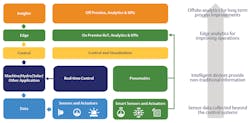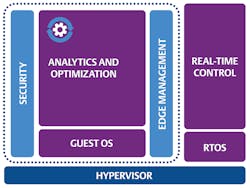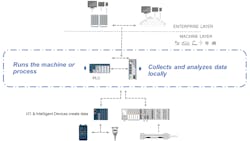Process productivity gains begin at the edge
Optimization efforts within any industrial company can take several forms. The equipment and systems can be made to perform better when process experts apply their knowledge. Better situational awareness assists those operating the processes to become more productive. Improved reliability minimizes the effort required by those maintaining the automation system. Each of these three examples relies on good decision-making data and includes a human element.
Many industries across the world find it difficult to find, hire and retain skilled workers for each of these engineering, operations and maintenance categories. That is why companies are so interested in projects to increase personnel productivity by gathering the right data and efficiently getting it into the hands of those who can make positive changes. Collectively, these big data efforts are known as the industrial internet of things (IIoT) or Industry 4.0. Both involve incorporating more intelligent edge devices, and interconnecting them on-site and in the cloud, to gather and consolidate disparate data.
Data availability is increasing rapidly, and Emerson surveys indicate more than 70% of industrial companies have determined it is critical for their business to establish an IIoT strategy by 2021 to create value from their data. The goal is to improve data usage to far above the 5% level common today, while increasing the productivity of their subject matter experts. Up to half of end users recognize a talent shortage regarding personnel able to use this data effectively, so they are actively looking for ways to close this gap.
Connected processes can be designed for smarter control and to help users make more intelligent decisions. Deploying edge computing for industrial and infrastructure processes is a smart investment in operations to attain IIoT goals for optimization.
Along those lines, this article will present the concept of applying edge automation controllers as a more effective way of gathering data, visualizing it and using it to improve value than traditional programmable logic controllers (PLCs) or supervisory control and data acquisition (SCADA) systems.
New data flows
Because traditional automation systems have always formed the front line of connectivity to field devices, they are usually the primary source of data. But this is no longer exclusively the case in many applications. Figure 1 indicates new options available with modern automation system architectures. The blue and yellow blocks indicate data flow from conventional sensors through traditional control and visualization systems, while the green blocks indicate on-premises IIoT computing and data flow. Both sources can be directed to off-premises analytics and key performance indicator (KPI) systems.
Standard sensors and actuators are commonly connected to real-time control systems, and this will continue to be the case. In turn, these control systems will supply data up to visualization and higher-level systems. But as we will see, even classic control platforms can benefit by connecting via edge computing equipment.
The growing availability of smart sensors makes it possible to install them in parallel with existing automation systems to supply even more data, often from non-traditional sources. These IIoT sensors and devices don’t need to report through the standard automation hierarchy because they are not required for real-time control. They might be used to monitor power usage, equipment vibration or environmental conditions, and they can be connected via various edge computing methods. As more IIoT devices come online beyond traditional industrial control systems, edge computing offers a way to integrate with IIoT implementations.
The advantage of incorporating edge computing on-site lies in its modern, IT-friendly hardware and software. Edge computing promotes easy integration with IT networks and the cloud, as well as the ability to do more computations and analysis close to the field. Data from traditional sensors is readily combined with data from smart IIoT sensors, leading to a holistic new view enabling analysis to optimize the entire process.
Multiple hardware options
There are several edge computing options available, described here in order of increasing capability.
Edge gateways are the most basic IIoT-enabling device. They are deployed simply to connect with intelligent source devices like PLCs or smart sensors, and then forward data on to higher-level systems both on-premises and off-premises for further analysis.
Edge computing devices include gateway features and add computational capabilities. Edge computing devices are not used for direct control, but they can preprocess data, perform calculations and execute other analysis tasks. Because they are located close to the machine or process, they have access to high-fidelity and low-latency data, and they reduce the computing and network load for upstream systems.
Edge controllers are the most capable and interesting edge computing option for implementing IIoT initiatives. Edge controllers are based on the latest multi-core processor hardware and use real-time hardware virtualization hypervisor to create two completely independent operating systems (Figure 2).
A real-time operating system executes a deterministic runtime to deliver reliable high-speed logic control — essentially a traditional PLC. A second general-purpose operating system, in this case Linux-based, lets users create applications much as they would using a PLC. This second system can be used for SCADA or other computing purposes. Each operating system is completely independent from a hardware and software standpoint, and each can even be rebooted without affecting the other (Figure 3).
Although the two operating systems are independent, they can interact with each other securely using OPC UA communications. This rigorous two-way communication can be used such that:
- The deterministic system supplies data to the general-purpose system
- The general-purpose system can use analytical and other results to inform the deterministic system of ideal operating values
While the general-purpose system has access to outside information from other IIoT field devices or higher-level systems, the deterministic system is carefully firewalled from these outside influences. The deterministic system can integrate with controlled equipment and I/O using the industrial PROFINET protocol. Users now have a means to enable centralized data analysis on the cloud, or decentralized analysis at the edge, or any combination of both, and closely coordinate it with real-time control.
Enabling capability as a service
Adding edge controllers or devices to any industrial system helps operators and maintenance personnel optimize and support the system. It also creates new possibilities such as “capability as a service” for a new revenue stream.
For instance, if processing equipment is supplied to an end user by an OEM, that OEM may already offer a conventional service contract for providing consumables, answering technical support calls and sending technicians to the field as needed.
Edge technology provides an opportunity for something more collaborative. The OEM can view equipment errors and performance in near-real-time over the cloud, allowing it to better support the end user with online access while saving the expense and delays of travel. An OEM can schedule shipments of consumables and repair parts based on equipment monitoring, and may also be able to use this edge technology as a way to offer upgrades and enhancements.
In some cases, it may make sense for the industrial equipment to be leased to the end user, with payments structured based on equipment throughput and uptime. Because the OEM is assuming more responsibility for the equipment performance, they need greater visibility into its operation, which edge technology can provide.
Renewable energy industry processes
Industrial end users operate many types of processes. For example, established energy industry sites operate not only the power generation equipment, but also many support systems that are processes themselves, such as cooling water and steam systems. Renewable energy producers such as hydropower microgenerators and even solar photovoltaic installations can be considered as processes where equipment operation must be optimized based on local conditions, and power generation capacity must be appropriately matched with grid demand.
All these processes are opportunities to transform basic standalone controls into integrated, IIoT-enabled systems. Edge analytics can process real-time and forecasted weather data, particularly critical for solar installations, in combination with grid data to determine optimal operating levels. Equipment performance can be tracked to enable predictive maintenance, lowering operating costs and minimizing outages. Micro-generation sites are locally controlled, and they can be linked in an economical and flexible fashion.
Progressive operators begin by adding IIoT systems in parallel with existing equipment to gather as much relevant data as possible. For new installations, they can specify IIoT-ready edge controllers. Once the data is available, operators can incrementally and systematically deploy edge-based and centralized analytics, using subject matter experts and machine learning algorithms to improve efficiency. Eventually, procedural approaches can be codified within controllers to realize completely automated and optimized systems.
Process optimization begins at the edge
Industrial operators of all types are investing in ways to deliver improved value through automation, whether they are upgrading legacy PLC and SCADA systems or building new ones. They can save money by implementing hardware and software to make equipment perform better, improve operator productivity and increase uptime.
Each of these goals requires good data as a foundation for making the best decisions. End users are recognizing that the key to obtaining the right data lies with implementing effective IIoT strategies. Edge computing, whether used to efficiently gather data or as a more advanced integrated control platform, now offers many options to securely and easily integrate classic OT automation with new IIoT devices, and to link these devices and controllers to the cloud using modern IT-based technologies.
Vibhoosh Gupta is a portfolio leader for Emerson’s machine automation solutions business unit and manages its portfolio of automation system, operator interface, industrial PC and Industrial IoT software and hardware products for industrial automation.



